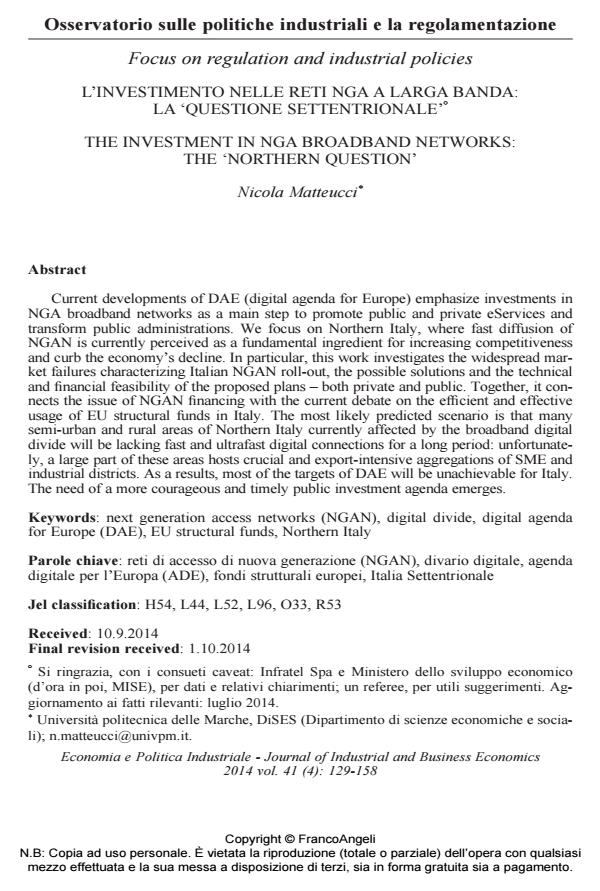L’investimento nelle reti NGA a larga banda: la "questione settentrionale"
Journal title ECONOMIA E POLITICA INDUSTRIALE
Author/s Nicola Matteucci
Publishing Year 2014 Issue 2014/4
Language English Pages 30 P. 129-158 File size 116 KB
DOI 10.3280/POLI2014-004007
DOI is like a bar code for intellectual property: to have more infomation
click here
Below, you can see the article first page
If you want to buy this article in PDF format, you can do it, following the instructions to buy download credits

FrancoAngeli is member of Publishers International Linking Association, Inc (PILA), a not-for-profit association which run the CrossRef service enabling links to and from online scholarly content.
Current developments of DAE (digital agenda for Europe) emphasize investments in NGA broadband networks as a main step to promote public and private eServices and transform public administrations. We focus on Northern Italy, where fast diffusion of NGAN is currently perceived as a fundamental ingredient for increasing competitiveness and curb the economy’s decline. In particular, this work investigates the widespread market failures characterizing Italian NGAN roll-out, the possible solutions and the technical and financial feasibility of the proposed plans - both private and public. Together, it connects the issue of NGAN financing with the current debate on the efficient and effective usage of EU structural funds in Italy. The most likely predicted scenario is that many semi-urban and rural areas of Northern Italy currently affected by the broadband digital divide will be lacking fast and ultrafast digital connections for a long period: unfortunately, a large part of these areas hosts crucial and export-intensive aggregations of SME and industrial districts. As a results, most of the targets of DAE will be unachievable for Italy. The need of a more courageous and timely public investment agenda emerges.
Keywords: Next generation access networks (NGAN), digital divide, digital agenda for Europe (DAE), EU structural funds, Northern Italy
Jel codes: H54, L44, L52, L96, O33, R53
- Innovations in Digital Economy Kirill Sarachuk, Magdalena Missler-Behr, Adrian Hellebrand, pp.40 (ISBN:978-3-030-84844-6)
- La copertura digitale del territorio rurale: un'analisi sui comuni marchigiani Marco Lorenzetti, Nicola Matteucci, in ECONOMIA E SOCIETÀ REGIONALE 2/2016 pp.92
DOI: 10.3280/ES2016-002007 - Sviluppo socio-economico e dotazione di banda larga nei comuni marchigiani Marco Lorenzetti, Nicola Matteucci, in PRISMA Economia - Società - Lavoro 3/2018 pp.199
DOI: 10.3280/PRI2016-003014 - E-government e capitale umano nella Pubblica Amministrazione italiana. Una prospettiva di medio periodo Nicola Matteucci, in PRISMA Economia - Società - Lavoro 2/2020 pp.31
DOI: 10.3280/PRI2019-002003 - Diffusione tecnologica e ICT: modelli ed applicazioni Silvio Di Fabio, in PRISMA Economia - Società - Lavoro 3/2018 pp.92
DOI: 10.3280/PRI2017-003009
Nicola Matteucci, L’investimento nelle reti NGA a larga banda: la "questione settentrionale" in "ECONOMIA E POLITICA INDUSTRIALE " 4/2014, pp 129-158, DOI: 10.3280/POLI2014-004007